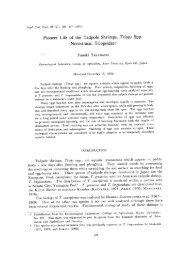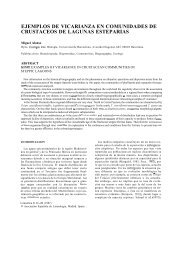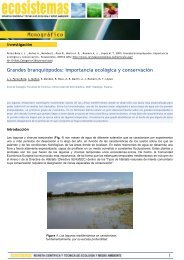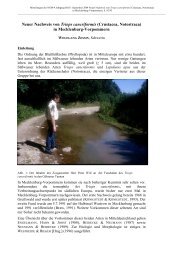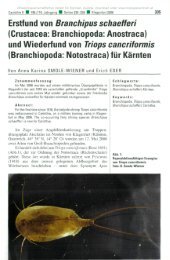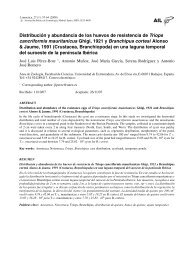Reproductive isolation and genetic differentiation in North American ...
Reproductive isolation and genetic differentiation in North American ...
Reproductive isolation and genetic differentiation in North American ...
Create successful ePaper yourself
Turn your PDF publications into a flip-book with our unique Google optimized e-Paper software.
138<br />
also have similar phenologies <strong>and</strong> life histories (Weeks,<br />
1990; Weeks & Sassaman, 1990). Although both<br />
species <strong>in</strong>habit some ponds <strong>in</strong> the valley, most of<br />
the habitats we exam<strong>in</strong>ed (roadside ditches <strong>and</strong> artificial<br />
impoundments) were occupied only by unisexual<br />
populations of T. longicaudatus. The two species<br />
also coexist at our Shallow Water, Kansas, site where<br />
sexual populations of both species occur without any<br />
<strong>genetic</strong> <strong>in</strong>dication of <strong>in</strong>trogression (Appendix 3).<br />
Discussion<br />
The <strong>North</strong> <strong>American</strong> species of Triops<br />
Although this contribution is not <strong>in</strong>tended to be a formal<br />
taxonomic revision of either <strong>North</strong> <strong>American</strong> Triops,<br />
or of those populations elsewhere that are currently<br />
subsumed under T. longicaudatus, some comment<br />
on nomenclature is <strong>in</strong> order. Our evidence of multiple<br />
species of Triops creates a need to establish the nomenclature<br />
of the forms. The oldest recognized description<br />
of Triops from <strong>North</strong> America is that of Triops longicaudatus<br />
(Le Conte, 1846); the prior description of T.<br />
obtusa (James) is generally not recognized s<strong>in</strong>ce the<br />
orig<strong>in</strong>al description was fragmentary <strong>and</strong> unaccompanied<br />
by any type material. Packard (1871) briefly<br />
described three additional species: T. lucasanus, T.<br />
newberryi <strong>and</strong> T. aequalis. He amplified those descriptions<br />
<strong>and</strong> provided figures <strong>in</strong> his monograph on <strong>North</strong><br />
<strong>American</strong> branchiopods (Packard, 1883). Two additional<br />
species, T. oryzaphagus <strong>and</strong> T. biggsi, were<br />
subsequently described from California rice fields by<br />
Rosenberg (1947). All of Packard’s (1871) <strong>and</strong> Rosenberg’s<br />
(1947) species were re-evaluated by L<strong>in</strong>der<br />
(1952), who exam<strong>in</strong>ed available type material of all<br />
forms. The pr<strong>in</strong>cipal characteristics of these various<br />
species, as based on the orig<strong>in</strong>al description or L<strong>in</strong>der’s<br />
subsequent re-description of type materials, is<br />
summarized <strong>in</strong> Table 6.<br />
In compil<strong>in</strong>g the table, we have st<strong>and</strong>ardized r<strong>in</strong>g<br />
counts, carapace ratios, <strong>and</strong> telson sp<strong>in</strong>e counts to the<br />
conventions used <strong>in</strong> our measurements. For example,<br />
some authors regard the term<strong>in</strong>al segment as a body<br />
r<strong>in</strong>g; we follow L<strong>in</strong>der (1952) <strong>in</strong> regard<strong>in</strong>g it as a telson.<br />
Various conventions have been used to determ<strong>in</strong>e<br />
carapace length, we have used the midl<strong>in</strong>e length. Telson<br />
sp<strong>in</strong>e counts vary <strong>in</strong> the literature depend<strong>in</strong>g upon<br />
whether only the medians are reported (as we do) or<br />
whether the posterior marg<strong>in</strong>al sp<strong>in</strong>es are also <strong>in</strong>cluded<br />
(see Longhurst, 1955a: Figure 5). LeConte’s (1846)<br />
description of T. longicaudatus is somewhat limited,<br />
<strong>and</strong> little of quantitative value can be extracted from it<br />
other than that his specimens had about 15 legless body<br />
r<strong>in</strong>gs. He actually mis<strong>in</strong>terpreted this region as be<strong>in</strong>g a<br />
post-anal tail, hence the specific epithet. The only other<br />
quantitative <strong>in</strong>formation on supposedly bona fide<br />
T. longicaudatus is <strong>in</strong> Packard’s (1883) monograph.<br />
The value of this monograph is compromised by the<br />
large number of errors it conta<strong>in</strong>s (Lynch, 1964), but<br />
we know of no other explicit description of T. longicaudatus.<br />
Packard’s (1883) redescription of males <strong>and</strong><br />
females was based on LeConte’s type <strong>and</strong> additional<br />
specimens from Texas. Quantitative data on Packard’s<br />
(1871) <strong>and</strong> Rosenberg’s (1947) species (Table 6) are<br />
based on the orig<strong>in</strong>al descriptions <strong>and</strong> L<strong>in</strong>der’s (1952)<br />
re-descriptions.<br />
Our analysis of morphological variation with<strong>in</strong> s<strong>in</strong>gle<br />
populations of Triops, <strong>and</strong> between populations that<br />
share substantial <strong>genetic</strong> identity, <strong>in</strong>dicate that slight<br />
meristic differences are not substantive <strong>in</strong>dicators of<br />
<strong>genetic</strong> <strong>differentiation</strong>. Thus, we see no basis for dist<strong>in</strong>guish<strong>in</strong>g<br />
between T. longicaudatus (LeConte, 1846)<br />
<strong>and</strong> T. lucasanus (Packard, 1871). Morphological characters<br />
of both males <strong>and</strong> females from gonochoric populations<br />
<strong>in</strong> the central United States correspond very<br />
closely to characters of the type specimens.<br />
The nomenclature of our second species is more<br />
problematic. There are two available names: T. newberryi<br />
(Packard, 1871) <strong>and</strong> T. aequalis (Packard, 1871),<br />
neither of which were described from many specimens<br />
or localitites. Packard (1883) regarded T. newberryi to<br />
be related closely to T. longicaudatus,<strong>and</strong> quite dist<strong>in</strong>ct<br />
<strong>in</strong> morphology from T. aequalis. Quantitative characters<br />
(Table 6), however, suggest that T. newberryi is<br />
as similar to T. aequalis <strong>in</strong> some characteristics (e.g.,<br />
carapace ratio <strong>and</strong> telson sp<strong>in</strong>ation) as it is to T. longicaudatus<br />
<strong>in</strong> others. Our second species corresponds to<br />
one of these two forms, but we cannot unambiguously<br />
elim<strong>in</strong>ate either. S<strong>in</strong>ce the reported geographical distribution<br />
of T. newberryi is more western, <strong>and</strong> s<strong>in</strong>ce T.<br />
newberryi has page priority over T. aequalis (Packard,<br />
1871) we tentatively restore T. newberryi as a valid<br />
species with T. aequalis as its junior synonym.<br />
L<strong>in</strong>der (1952) viewed the body r<strong>in</strong>g data for <strong>North</strong><br />
<strong>American</strong> Triops as represent<strong>in</strong>g a ‘cont<strong>in</strong>uous series’,<br />
rang<strong>in</strong>g from the shortest-bodied forms (T. oryzaphagus)<br />
to the longest-bodied forms (T. longicaudatus)<br />
<strong>and</strong>, largely on that basis, he synonymized all<br />
the described forms. Indeed, our morphological data,<br />
aggregated over all samples (Figure 4B) would be<br />
completely consistent with his <strong>in</strong>terpretation. How-



